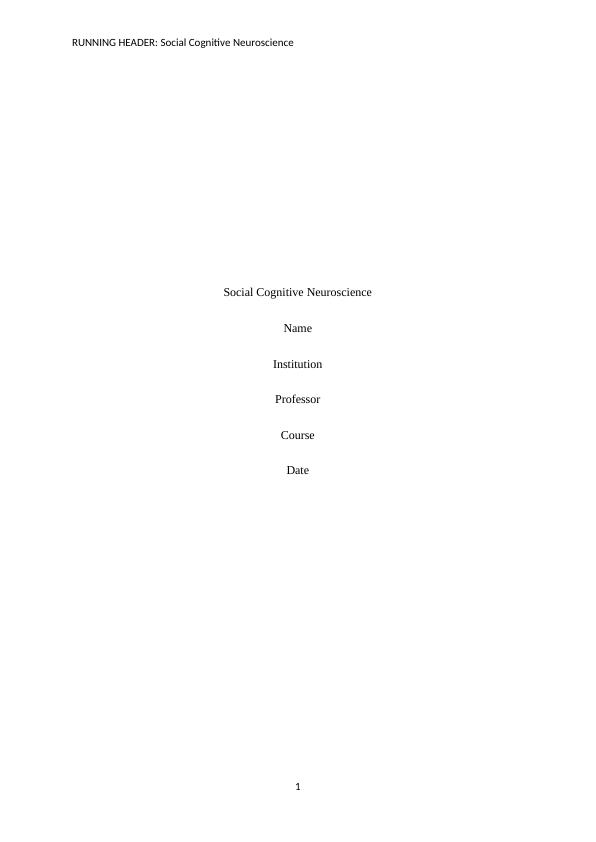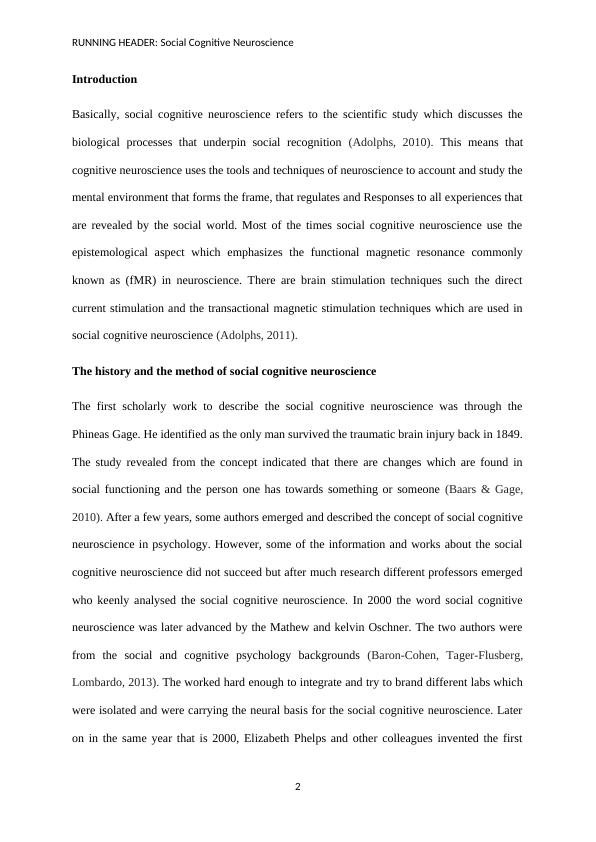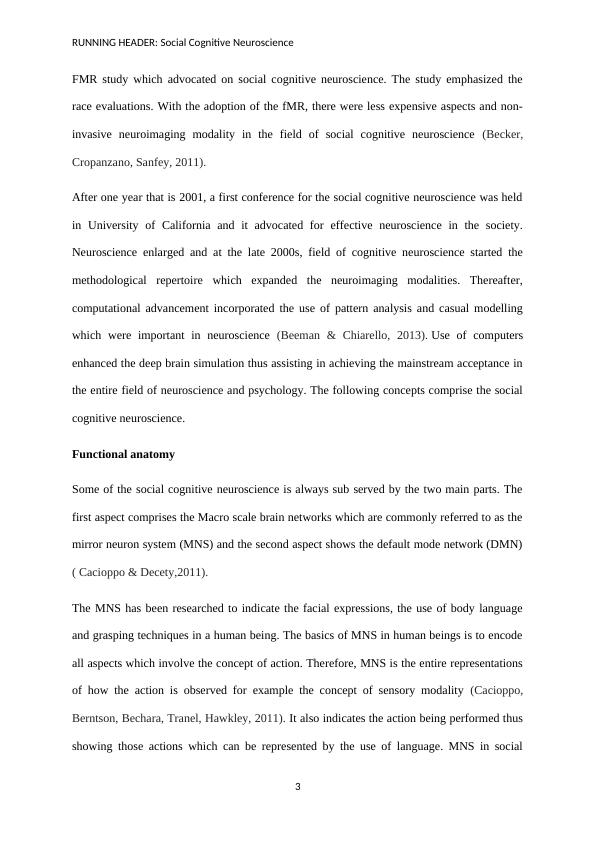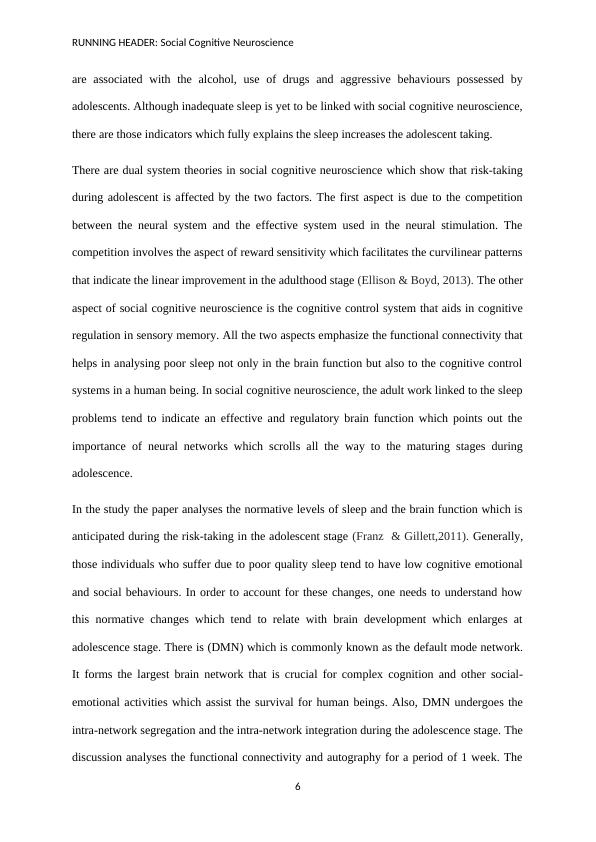Social Cognitive Neuroscience
Added on 2023-04-19
21 Pages6475 Words305 Views
RUNNING HEADER: Social Cognitive Neuroscience
Social Cognitive Neuroscience
Name
Institution
Professor
Course
Date
1
Social Cognitive Neuroscience
Name
Institution
Professor
Course
Date
1

RUNNING HEADER: Social Cognitive Neuroscience
Introduction
Basically, social cognitive neuroscience refers to the scientific study which discusses the
biological processes that underpin social recognition (Adolphs, 2010). This means that
cognitive neuroscience uses the tools and techniques of neuroscience to account and study the
mental environment that forms the frame, that regulates and Responses to all experiences that
are revealed by the social world. Most of the times social cognitive neuroscience use the
epistemological aspect which emphasizes the functional magnetic resonance commonly
known as (fMR) in neuroscience. There are brain stimulation techniques such the direct
current stimulation and the transactional magnetic stimulation techniques which are used in
social cognitive neuroscience (Adolphs, 2011).
The history and the method of social cognitive neuroscience
The first scholarly work to describe the social cognitive neuroscience was through the
Phineas Gage. He identified as the only man survived the traumatic brain injury back in 1849.
The study revealed from the concept indicated that there are changes which are found in
social functioning and the person one has towards something or someone (Baars & Gage,
2010). After a few years, some authors emerged and described the concept of social cognitive
neuroscience in psychology. However, some of the information and works about the social
cognitive neuroscience did not succeed but after much research different professors emerged
who keenly analysed the social cognitive neuroscience. In 2000 the word social cognitive
neuroscience was later advanced by the Mathew and kelvin Oschner. The two authors were
from the social and cognitive psychology backgrounds (Baron-Cohen, Tager-Flusberg,
Lombardo, 2013). The worked hard enough to integrate and try to brand different labs which
were isolated and were carrying the neural basis for the social cognitive neuroscience. Later
on in the same year that is 2000, Elizabeth Phelps and other colleagues invented the first
2
Introduction
Basically, social cognitive neuroscience refers to the scientific study which discusses the
biological processes that underpin social recognition (Adolphs, 2010). This means that
cognitive neuroscience uses the tools and techniques of neuroscience to account and study the
mental environment that forms the frame, that regulates and Responses to all experiences that
are revealed by the social world. Most of the times social cognitive neuroscience use the
epistemological aspect which emphasizes the functional magnetic resonance commonly
known as (fMR) in neuroscience. There are brain stimulation techniques such the direct
current stimulation and the transactional magnetic stimulation techniques which are used in
social cognitive neuroscience (Adolphs, 2011).
The history and the method of social cognitive neuroscience
The first scholarly work to describe the social cognitive neuroscience was through the
Phineas Gage. He identified as the only man survived the traumatic brain injury back in 1849.
The study revealed from the concept indicated that there are changes which are found in
social functioning and the person one has towards something or someone (Baars & Gage,
2010). After a few years, some authors emerged and described the concept of social cognitive
neuroscience in psychology. However, some of the information and works about the social
cognitive neuroscience did not succeed but after much research different professors emerged
who keenly analysed the social cognitive neuroscience. In 2000 the word social cognitive
neuroscience was later advanced by the Mathew and kelvin Oschner. The two authors were
from the social and cognitive psychology backgrounds (Baron-Cohen, Tager-Flusberg,
Lombardo, 2013). The worked hard enough to integrate and try to brand different labs which
were isolated and were carrying the neural basis for the social cognitive neuroscience. Later
on in the same year that is 2000, Elizabeth Phelps and other colleagues invented the first
2

RUNNING HEADER: Social Cognitive Neuroscience
FMR study which advocated on social cognitive neuroscience. The study emphasized the
race evaluations. With the adoption of the fMR, there were less expensive aspects and non-
invasive neuroimaging modality in the field of social cognitive neuroscience (Becker,
Cropanzano, Sanfey, 2011).
After one year that is 2001, a first conference for the social cognitive neuroscience was held
in University of California and it advocated for effective neuroscience in the society.
Neuroscience enlarged and at the late 2000s, field of cognitive neuroscience started the
methodological repertoire which expanded the neuroimaging modalities. Thereafter,
computational advancement incorporated the use of pattern analysis and casual modelling
which were important in neuroscience (Beeman & Chiarello, 2013). Use of computers
enhanced the deep brain simulation thus assisting in achieving the mainstream acceptance in
the entire field of neuroscience and psychology. The following concepts comprise the social
cognitive neuroscience.
Functional anatomy
Some of the social cognitive neuroscience is always sub served by the two main parts. The
first aspect comprises the Macro scale brain networks which are commonly referred to as the
mirror neuron system (MNS) and the second aspect shows the default mode network (DMN)
( Cacioppo & Decety,2011).
The MNS has been researched to indicate the facial expressions, the use of body language
and grasping techniques in a human being. The basics of MNS in human beings is to encode
all aspects which involve the concept of action. Therefore, MNS is the entire representations
of how the action is observed for example the concept of sensory modality (Cacioppo,
Berntson, Bechara, Tranel, Hawkley, 2011). It also indicates the action being performed thus
showing those actions which can be represented by the use of language. MNS in social
3
FMR study which advocated on social cognitive neuroscience. The study emphasized the
race evaluations. With the adoption of the fMR, there were less expensive aspects and non-
invasive neuroimaging modality in the field of social cognitive neuroscience (Becker,
Cropanzano, Sanfey, 2011).
After one year that is 2001, a first conference for the social cognitive neuroscience was held
in University of California and it advocated for effective neuroscience in the society.
Neuroscience enlarged and at the late 2000s, field of cognitive neuroscience started the
methodological repertoire which expanded the neuroimaging modalities. Thereafter,
computational advancement incorporated the use of pattern analysis and casual modelling
which were important in neuroscience (Beeman & Chiarello, 2013). Use of computers
enhanced the deep brain simulation thus assisting in achieving the mainstream acceptance in
the entire field of neuroscience and psychology. The following concepts comprise the social
cognitive neuroscience.
Functional anatomy
Some of the social cognitive neuroscience is always sub served by the two main parts. The
first aspect comprises the Macro scale brain networks which are commonly referred to as the
mirror neuron system (MNS) and the second aspect shows the default mode network (DMN)
( Cacioppo & Decety,2011).
The MNS has been researched to indicate the facial expressions, the use of body language
and grasping techniques in a human being. The basics of MNS in human beings is to encode
all aspects which involve the concept of action. Therefore, MNS is the entire representations
of how the action is observed for example the concept of sensory modality (Cacioppo,
Berntson, Bechara, Tranel, Hawkley, 2011). It also indicates the action being performed thus
showing those actions which can be represented by the use of language. MNS in social
3

RUNNING HEADER: Social Cognitive Neuroscience
cognitive neuroscience comprises the promoter cortex, the intraparietal sulcus and the lateral
occipitotemporal cortex known as the (LOTC). The intraparietal sulcus in social cognitive
neuroscience shows that in human the censoring mirroring responses are always directed to
the anterior intraparietal sulcus. The part is more sensitive and it assists in monitoring the
biological actions which are entirely relative to the semantic features. In addition, the
intraparietal sulcus is linked to the dorsal visual stream, which forms the posterior and the
temporal sulcus (Christoff, Cosmelli, Legrand, Thompson, 2011). On explaining the
premotor cortex different researchers have identified that it's a region which comprises
diverse arrays of functions. It encompasses the motor planning and sensory guidance that is
in visual movements. It also assists in language processing in the field of social cognitive
neuroscience. The LOTC shows the lateral regions which are associated with the visual
processing and the sensory monitoring. The part shows the regions which are sensitive to
objects, sensitive t body parts and body postures which are vital in the human being. The
LOTC is believed to encode on sensorimotor and also binding together the different aspects
by initiating different actions which are carried out in social cognitive neuroscience (Couture,
Penn, Losh, Adolphs, Hurley, Piven, 2010).
The DMN aids in processing social information, for example, the mental states and the
intentions or traits. Social cognitive basically focuses on emotion, memorializing, empathy
and moral cognition. All the regions consistently emphasize neuroimaging studies in the field
of social cognitive neuroscience. The DMN has been identified to involve in memory-related
processing aspects which controls the traits and action from a human being. Most of the
DMN activities are experienced during rest as the activation and the connectivity are
enhanced through cognition (Decety & Lamm, 2011). DMN comprises the Medial Prefrontal
cortex, the posterior cingulate cortex, the temporoparietal junction, and the superior temporal
sulcus. All the parts of DMN work to initiate sensory aspects which enhances neuron system.
4
cognitive neuroscience comprises the promoter cortex, the intraparietal sulcus and the lateral
occipitotemporal cortex known as the (LOTC). The intraparietal sulcus in social cognitive
neuroscience shows that in human the censoring mirroring responses are always directed to
the anterior intraparietal sulcus. The part is more sensitive and it assists in monitoring the
biological actions which are entirely relative to the semantic features. In addition, the
intraparietal sulcus is linked to the dorsal visual stream, which forms the posterior and the
temporal sulcus (Christoff, Cosmelli, Legrand, Thompson, 2011). On explaining the
premotor cortex different researchers have identified that it's a region which comprises
diverse arrays of functions. It encompasses the motor planning and sensory guidance that is
in visual movements. It also assists in language processing in the field of social cognitive
neuroscience. The LOTC shows the lateral regions which are associated with the visual
processing and the sensory monitoring. The part shows the regions which are sensitive to
objects, sensitive t body parts and body postures which are vital in the human being. The
LOTC is believed to encode on sensorimotor and also binding together the different aspects
by initiating different actions which are carried out in social cognitive neuroscience (Couture,
Penn, Losh, Adolphs, Hurley, Piven, 2010).
The DMN aids in processing social information, for example, the mental states and the
intentions or traits. Social cognitive basically focuses on emotion, memorializing, empathy
and moral cognition. All the regions consistently emphasize neuroimaging studies in the field
of social cognitive neuroscience. The DMN has been identified to involve in memory-related
processing aspects which controls the traits and action from a human being. Most of the
DMN activities are experienced during rest as the activation and the connectivity are
enhanced through cognition (Decety & Lamm, 2011). DMN comprises the Medial Prefrontal
cortex, the posterior cingulate cortex, the temporoparietal junction, and the superior temporal
sulcus. All the parts of DMN work to initiate sensory aspects which enhances neuron system.
4

RUNNING HEADER: Social Cognitive Neuroscience
The superior temporal sulcus enhances the social vision and the biological motion processing
which very vital for social cognitive neuroscience. Temporoparietal junction forms the
distinguishing aspects between the multiple agents, for example, the self and other. It is also
associated with the contextual updating, the language processing and the episode memory
which enhances the social and non-social function. However, Temporoparietal junction
function in neural encoding techniques and that's why it is constituted in the social, temporal
and spatial distance on social cognitive neuroscience (D’esposito & Postle, 2015).
How social cognitive neuroscience is related to the topic used.
Adolescence stage impacts the sleep and risk-taking in human beings. Good sleep is very
important in our bodies. The aspect of good sleep plays a consequential role in the field of
social cognitive neuroscience. During adolescence, good sleep is very important since it helps
in developing other consequential stages. When one experiences poor sleep he or she
experiences a deficit in cognitive and emotional deficits. It includes the bias which is entirely
towards the high-risk behaviour and diminished behavioural controls which facilitates poor
emotion regulation in a human being (D'esposito & Postle, 2015). Different researches have
indicated that sleep deprivation results to brain malfunctioning thus causing brain function
which relates to the risk-taking and cognition. There are also a few studies which have tried
to reveal the study of sleep and brain functioning. This means that much effort is induced in
the study of neural mechanisms whereby the sleep changes with an increase in adolescence.
The issue of sleep deprivation at the adolescence stage, tend to occur with a normative
developmental increase in risk-taking and poor decision which affects the social cognitive
neuroscience. Those adolescents who are deprived of sleep are believed to possess decreased
cognitive modulations, decreased impulses, and emotions which are unable to respond to the
control of attention (Dimoka,Pavlou,Davis, 2011). Most of the sleepless moments and nights
5
The superior temporal sulcus enhances the social vision and the biological motion processing
which very vital for social cognitive neuroscience. Temporoparietal junction forms the
distinguishing aspects between the multiple agents, for example, the self and other. It is also
associated with the contextual updating, the language processing and the episode memory
which enhances the social and non-social function. However, Temporoparietal junction
function in neural encoding techniques and that's why it is constituted in the social, temporal
and spatial distance on social cognitive neuroscience (D’esposito & Postle, 2015).
How social cognitive neuroscience is related to the topic used.
Adolescence stage impacts the sleep and risk-taking in human beings. Good sleep is very
important in our bodies. The aspect of good sleep plays a consequential role in the field of
social cognitive neuroscience. During adolescence, good sleep is very important since it helps
in developing other consequential stages. When one experiences poor sleep he or she
experiences a deficit in cognitive and emotional deficits. It includes the bias which is entirely
towards the high-risk behaviour and diminished behavioural controls which facilitates poor
emotion regulation in a human being (D'esposito & Postle, 2015). Different researches have
indicated that sleep deprivation results to brain malfunctioning thus causing brain function
which relates to the risk-taking and cognition. There are also a few studies which have tried
to reveal the study of sleep and brain functioning. This means that much effort is induced in
the study of neural mechanisms whereby the sleep changes with an increase in adolescence.
The issue of sleep deprivation at the adolescence stage, tend to occur with a normative
developmental increase in risk-taking and poor decision which affects the social cognitive
neuroscience. Those adolescents who are deprived of sleep are believed to possess decreased
cognitive modulations, decreased impulses, and emotions which are unable to respond to the
control of attention (Dimoka,Pavlou,Davis, 2011). Most of the sleepless moments and nights
5

RUNNING HEADER: Social Cognitive Neuroscience
are associated with the alcohol, use of drugs and aggressive behaviours possessed by
adolescents. Although inadequate sleep is yet to be linked with social cognitive neuroscience,
there are those indicators which fully explains the sleep increases the adolescent taking.
There are dual system theories in social cognitive neuroscience which show that risk-taking
during adolescent is affected by the two factors. The first aspect is due to the competition
between the neural system and the effective system used in the neural stimulation. The
competition involves the aspect of reward sensitivity which facilitates the curvilinear patterns
that indicate the linear improvement in the adulthood stage (Ellison & Boyd, 2013). The other
aspect of social cognitive neuroscience is the cognitive control system that aids in cognitive
regulation in sensory memory. All the two aspects emphasize the functional connectivity that
helps in analysing poor sleep not only in the brain function but also to the cognitive control
systems in a human being. In social cognitive neuroscience, the adult work linked to the sleep
problems tend to indicate an effective and regulatory brain function which points out the
importance of neural networks which scrolls all the way to the maturing stages during
adolescence.
In the study the paper analyses the normative levels of sleep and the brain function which is
anticipated during the risk-taking in the adolescent stage (Franz & Gillett,2011). Generally,
those individuals who suffer due to poor quality sleep tend to have low cognitive emotional
and social behaviours. In order to account for these changes, one needs to understand how
this normative changes which tend to relate with brain development which enlarges at
adolescence stage. There is (DMN) which is commonly known as the default mode network.
It forms the largest brain network that is crucial for complex cognition and other social-
emotional activities which assist the survival for human beings. Also, DMN undergoes the
intra-network segregation and the intra-network integration during the adolescence stage. The
discussion analyses the functional connectivity and autography for a period of 1 week. The
6
are associated with the alcohol, use of drugs and aggressive behaviours possessed by
adolescents. Although inadequate sleep is yet to be linked with social cognitive neuroscience,
there are those indicators which fully explains the sleep increases the adolescent taking.
There are dual system theories in social cognitive neuroscience which show that risk-taking
during adolescent is affected by the two factors. The first aspect is due to the competition
between the neural system and the effective system used in the neural stimulation. The
competition involves the aspect of reward sensitivity which facilitates the curvilinear patterns
that indicate the linear improvement in the adulthood stage (Ellison & Boyd, 2013). The other
aspect of social cognitive neuroscience is the cognitive control system that aids in cognitive
regulation in sensory memory. All the two aspects emphasize the functional connectivity that
helps in analysing poor sleep not only in the brain function but also to the cognitive control
systems in a human being. In social cognitive neuroscience, the adult work linked to the sleep
problems tend to indicate an effective and regulatory brain function which points out the
importance of neural networks which scrolls all the way to the maturing stages during
adolescence.
In the study the paper analyses the normative levels of sleep and the brain function which is
anticipated during the risk-taking in the adolescent stage (Franz & Gillett,2011). Generally,
those individuals who suffer due to poor quality sleep tend to have low cognitive emotional
and social behaviours. In order to account for these changes, one needs to understand how
this normative changes which tend to relate with brain development which enlarges at
adolescence stage. There is (DMN) which is commonly known as the default mode network.
It forms the largest brain network that is crucial for complex cognition and other social-
emotional activities which assist the survival for human beings. Also, DMN undergoes the
intra-network segregation and the intra-network integration during the adolescence stage. The
discussion analyses the functional connectivity and autography for a period of 1 week. The
6

End of preview
Want to access all the pages? Upload your documents or become a member.
Related Documents
Social Cognitive Neuroscience: Contributions of Language to Exposure Therapylg...
|20
|5870
|360
Biological Psychology Assignmentlg...
|13
|3497
|109
Psychology: Understanding the Emergent Properties of the Brainlg...
|5
|847
|450
